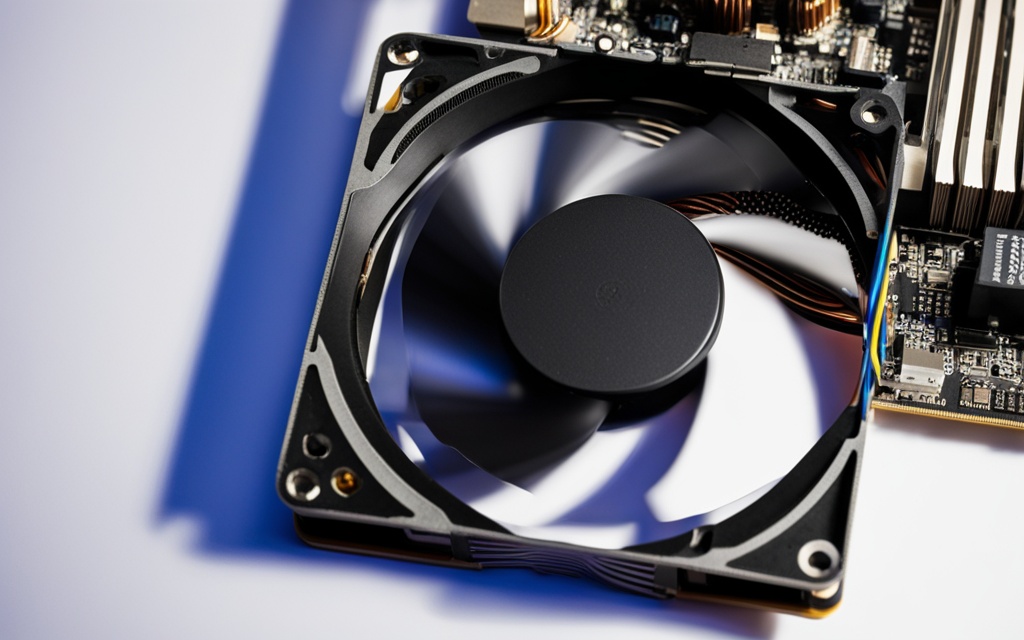Table of Contents
Getting the size of your CPU fan right is key to better computer performance and keeping it cool. Knowing the best CPU cooling system starts with measuring your fan accurately. This is mainly about checking the fan blade diameter. Fans usually come in standard sizes to make things easier. For instance, a 76mm blade fan is often known as an 80mm fan. The correct way to measure CPU fan size ensures your computer works well and stays cool. It’s important to know the different PC cooling fan sizes, like the common 80mm, 120mm, and 140mm. These sizes match various cooling needs and computer setups123.
Key Takeaways
- The best method to achieve an optimal CPU cooling solution begins with accurate measurements.
- Standard fan sizes include 40mm to 220mm, with common variants like 80mm, 120mm, and 140mm.
- Airflow and noise levels significantly impact the overall performance of your cooling system.
- Types of bearings used in fans can influence noise levels and efficiency.
- Choosing the right size can make a substantial difference in the effectiveness of your cooling setup.
Understanding the Importance of CPU Fan Size
A CPU fan’s size is critical for your computer’s peak performance and life span. It cools different parts, stopping them from getting too hot and breaking. Keeping your computer at the right temperature boosts its efficiency a lot.
The Role of CPU Fans in Computer Cooling
CPU fans make sure air moves around inside the computer case. Fans that are 120 mm and 140 mm are great for most desktops because they’re quiet but still cool well3. Smaller PCs work well with fans that are 20 mm, 40 mm, or 80 mm. These are good in tight spaces3.
For people who use their computers a lot or for overclocking, fans that are 180 mm or 200 mm are better3. Fans designed with special blades help with better air flow and make less noise. This improves how the computer feels to use.
Impact on Performance and Noise Levels
The size of the fan affects how the computer works and sounds. Big fans are quieter because they don’t need to spin as fast to move air. Different types of bearings, like ball or hydraulic, also play a role in how much noise a fan makes. Hydraulic bearings are quieter but cost more34,).
Being able to control a fan’s speed is beneficial. It means the fan can change how it works based on what the computer is doing. It turns up for intense tasks but slows down when the load is light34,). Choosing the right fan size is important for keeping your computer silent and efficient.
How to Measure CPU Fan Size
Getting the size of your CPU fan right is key for great performance and fitting it in your PC. You need the correct fan measurement tools for accurate results. This method will help you find the right fan size, whether you’re replacing an old one or putting in a new one.
Tools Needed for Accurate Measurement
First things first, gather these tools:
- Ruler or measuring tape
- Callipers (for exact measurements)
- Paper and pen for jotting down numbers
These fan measurement tools make the task easier and more precise.
Step-by-Step Measuring Process
Follow these important steps:
- Measure across the fan blades at their widest part to get the diameter. This ensures you know the exact size.
- See if the frame of the fan adds extra size to its overall dimensions.
- Check the space between screw holes. This affects whether the fan fits your PC.
- Measure without letting the fan’s case get in the way to avoid sizing mistakes.
- Compare your measurements with common fan sizes like 40mm, 80mm, 120mm, and bigger to find the perfect match.
These steps help make sure you choose the right CPU fan size. It helps your cooling system work better.
| Model | Size (mm) | Price ($) | Airflow (CFM) | Noise Level (dB) |
|---|---|---|---|---|
| Fan A | 40 | 38.74 | 20.5 | 7 |
| Fan B | 80 | 31.16 | 35.8 | 23 |
| Fan C | 120 | 18.25 | 60.0 | 30 |
| Fan D | 140 | 13.93 | 70.5 | 28.4 |
| Fan E | Intensive Model | 10.98 | 79.8 | 35.8 |
This table is a handy reference for different CPU fan models. It shows their sizes and other important details.
Use these measurements when researching. They’ll help you understand better and ensure your fans fit right. This leads to more efficient cooling51.
Common Fan Sizes and Their Applications
Knowing about fan sizes is key to making your PC cooler. Fans from 40mm to 220mm help manage heat, with 120mm fans being most popular. They fit well in smaller PC builds. Choosing the right size fan is critical for good airflow and keeping your system cool.
Standard Sizes in Modern PCs
Fans come in several sizes like 80mm, 92mm, 120mm, and up to 220mm for bigger systems. The 120mm fans are common but 140mm fans move more air and are quieter. For PCs that work hard, using three or more fans prevents them from getting too hot. The bigger fans are better as they’re effective and make less noise67.
Choosing the Right Size for Your Setup
Choosing fans means looking at your case and what you’ll do with your PC. Big 200mm fans are great for gaming or demanding tasks. But smaller fans might be okay for everyday use. Putting a fan at the front to pull in cool air and another at the back to push out hot air is a smart move7.
Additional Specifications to Consider
It’s key to know your CPU fan’s specs to boost your computer’s function. Different elements can greatly change fan performance. Knowing them can make your system quieter and more effective.
Types of Fan Connectors: 3-pin vs 4-pin
Fans connect to motherboards or power supplies through certain connectors. The usual types are 3-pin and 4-pin. The 3-pin connector offers basic power and keeps an eye on functions. Meanwhile, the 4-pin connector adds PWM (Pulse Width Modulation) control. This allows for precise changes in speed, aiding in better cooling.
Speed and Airflow Ratings (RPM and CFM)
The speed and airflow of CPU fans are shown in RPM and CFM. RPM tells us how quickly the fan turns. CFM shows how much air the fan moves. For example, a 120mm fan’s speed may vary from 200 to 1800 RPM. It can create airflow of about 56.3 CFM8. Knowing about RPM and CFM can help pick the right fan for your setup.
Power Consumption and Noise Levels
In choosing a fan, think about how much power it uses. This is measured in Amps and changed to watts for total energy use. Noise level is also important and is measured in decibels. Quieter fans, like liquid coolers and low-noise air coolers, are best for silent places. Finding a fan that balances power use and noise well is key for a good working space.
By understanding these specs, you can choose the right CPU cooling solution. This helps keep your system stable and running well9.
Upgrading Your CPU Fan: What to Keep in Mind
When looking to upgrade CPU fans, checking fan compatibility with your PC case and heatsinks is key. It’s easy to miss checking the maximum fan size your setup can handle. This oversight can limit your system’s cooling ability and performance. Ensure the fan you choose fits well with your components’ dimensions and design.
Compatibility with PC Cases and Heatsinks
It’s essential to know that not every fan fits every setup. Cooling fans often come in 120mm and 140mm sizes. The larger 140mm fans offer better airflow, thanks to their bigger blades10. Brands like Noctua remind us to check fan compatibility, especially with larger coolers in smaller systems11. Always look at manufacturer guidelines to avoid problems.
Styles and Aesthetic Preferences for DIY Builds
If you’re into DIY PC builds, the look of the fan matters as much as performance. The fan’s design can greatly influence your setup’s visual appeal. There are fans with RGB lighting and different colour schemes. These features allow you to show your style while keeping your PC cool10. This balance between functionality and design makes building PCs more enjoyable and personal.
Considering both upgrading CPU fans for compatibility and style is crucial for a great build. Knowing how these aspects work together helps you make smart choices. These choices should meet your performance needs and match your taste.
Conclusion
When talking about CPU fan sizes, knowing how to measure them rightly is key. This ensures your computer works well and stays cool. Measuring wrong can lead to poor airflow and overheating, harming your system in the long run.
Choosing the correct fan size matters a lot. It also helps to look at things like how much heat it can handle and noise levels. This way, your PC stays cooler and works better in a quieter environment.
When picking a fan, whether it’s a versatile 120mm or a quieter 200mm, knowing the right size is vital. It keeps your computer parts safe. Making smart choices results in a system that works well, runs smoothly, and suits your needs.
As you improve your PC, a smart look at cooling will make your computer last longer. It also boosts productivity and fun. Take what you’ve learned here to choose the best CPU fan. This choice will change your setup for the better121314.
FAQ
How do I determine the appropriate CPU fan size for my computer?
To find the right CPU fan size, measure the fan blade’s width at its widest. Make sure it matches your computer’s case. Also, think about its airflow needs for gaming or high tasks.
What are the risks of using an inadequately sized CPU fan?
A small CPU fan might not cool well, leading to overheating. This could slow down the CPU and shorten the life of your parts.
Can I use a larger fan than my CPU cooler recommends?
Using a bigger fan may boost airflow and cooling. But, make sure it fits in your case without blocking other parts. Always check the fan size limit.
What is the difference between 3-pin and 4-pin fan connectors?
A 3-pin connector powers and checks the fan. A 4-pin connector also controls speed with PWM for better efficiency and performance.
How do RPM and CFM ratings influence CPU fan performance?
The RPM shows the fan’s speed, affecting airflow. CFM measures air volume moved. More RPM means more CFM, better cooling.
What are some common standard fan sizes I should consider?
Standard fan sizes are 40mm, 80mm, 92mm, 120mm, and 140mm. Some cases fit bigger fans, up to 200-220mm, for airflow needs.
How do I check the power consumption of a CPU fan?
Look at the fan’s specs for power use in Amps. Then, calculate watts with: watts = volts x amps. This helps figure out power supply needs.
What should I consider when upgrading my CPU fan for aesthetic purposes?
If upgrading for looks, choose color, LED features, and design that matches your build. Make sure the new fan works well while looking good.
Source Links
- https://www.linkedin.com/advice/3/how-do-you-choose-best-fan-size-speed-your-pc – How do you choose the best fan size and speed for your PC case?
- https://voltcave.com/measure-pc-fan/ – How to Measure a PC Fan’s Size: A Quick Guide – Voltcave
- https://www.akyga.com/news-list/86-computer-fan-a-guide-to-sizes-and-types.html – Computer fan – a guide to sizes and types
- https://www.lenovo.com/us/en/glossary/fan/ – How Does a Computer Fan Work? | Different Types Explained
- https://www.quietpc.com/casefans – Quiet Computer Fans for a Virtually Silent PC
- https://en.wikipedia.org/wiki/Computer_fan – Computer fan
- https://www.microcenter.com/site/mc-news/article/case-fans-buying-guide.aspx – Case Fans Buying Guide – What You Need to Know
- https://smartdevicefaqs.com/types-of-computer-fans/ – Types of Computer (PC) Fans: Purpose, Size, and Ratings Explained
- https://www.linkedin.com/pulse/choosing-right-cpu-cooling-fan-your-build-factors-consider-liang-dehec – Choosing the Right CPU Cooling Fan for Your Build: Factors to Consider
- https://www.titanrig.com/blog/post/water-cooling-components-fans – PC Case Fans – Function and Considerations | TITAN RIG Blog
- https://noctua.at/en/buying-guide-cpu-coolers – Buying guide CPU coolers
- https://blog.logicalincrements.com/2021/08/aftermarket-cpu-cooler-guide/ – Beginner’s Guide to CPU Coolers – Logical Increments Blog
- https://beanstalk.io/pc-fan-sizes/ – PC Case Fan Sizes Explained: Everything You Need to Know
- https://softwareg.com.au/blogs/computer-hardware/how-to-know-if-cpu-fan-will-fit – How To Know If CPU Fan Will Fit








